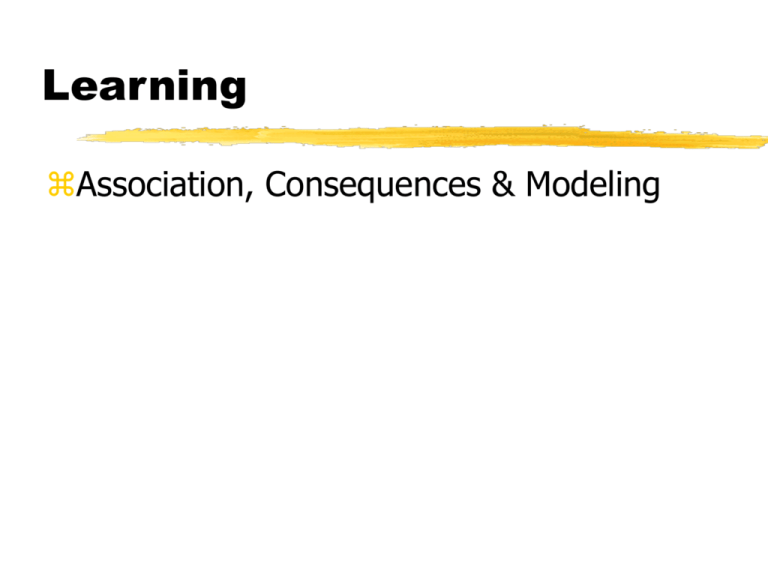Conditioned
advertisement

Learning Association, Consequences & Modeling Learning Learning Relatively permanent change in an organism’s behavior due to experience Experience (nurture) is the key to learning Learning before Cortex before & after kitten trained to associate horizontal line with shock after 3 Types of Learning Event 1 Event 2 Association Objects/behavior Consequences Behavior & results Sea snail associates splash w/ a shock Observation Seal learns to expect a snack for its antics Imitate/model Classical Conditioning (Association) Ivan Pavlov 1849-1936 Russian physician/ neurophysiologist Nobel Prize in 1904 Studied digestive secretions Pavlov Present meat powder to dogs Measure digestive processes (saliva) Noticed saliva production in absence of meat Experimenter Drawer where meat was kept Dogs responding to environmental stimuli associated with meat Classical Conditioning Some stimuli cause automatic response Loud noise/shock/food Some stimuli do not cause response Bell/light These 2 kinds of S can become associated Occur close together in time This association can cause a response to stimuli that usually do not cause response Examples of Associations Toilet flushes in shower Can opener & cat food Dentist office & pain cringe meow fear Associate initially meaningless stimuli with meaningful one Classical Conditioning - Terms Conditioned = ‘learned’ Neutral (S) - does not elicit a R Tone or bell Unconditioned (S) - automatically elicits an Unconditioned R Shock Association formed by pairing these two (S) together Classical Conditioning - Terms Neutral (S) causes a R & is now called a conditioned (S) Conditioned (S) - elicits a CR UCR~CR UCR caused by UCS CR caused by CS Classical Conditioning UCS - meaningful (S) UCR - unlearned (R) CS - formerly neutral (S) CR - learned (R) to CS UCR CR Classical Conditioning Learned association between neutral (S) & unconditioned (S) such that you R to neutral (S) as you did to Unc (S) can opener & cat food meow NS UCS UCR can opener meow CS CR Classical Conditioning Little Albert CC video demo Reaction Paper V: CC What is classical conditioning? Define the following: UCS, UCR, CS, CSR and provide a NOVEL example of CC in action PLEASE TURN THESE IN AFTER CLASS! Conditioning Acquisition Response is established/ strengthened Stimulus evokes a CR Strengthening of a CR Extinction Diminishing of a CR UCS does not follow a CS Spontaneous Recovery Reappearance, after a rest period Classical Conditioning Strength of CR Acquisition (CS+UCS) Extinction (CS alone) Spontaneous recovery of CR Extinction (CS alone) Pause Stimulus Generalization Tendency for a stimuli similar to CS to evoke similar responses Principles of CC No conscious effort Advertising Love Strength of UCS Strong enough -> UCR Frequency & timing of pairings Many trials NS shortly before UCS Higher Order Conditioning My Fear of Pajamas Initial conditioning NS(dark)+UCS(thunder) CS(dark) Higher order conditioning NS(pajamas)+CS(dark) CS(pajamas) UCR(fear) CR(fear) CR(fear) CR(fear) Operant Conditioning (Skinner (1904-1990) Beh operates (acts) on environment Produces consequences (reinforcer or punisher) Consequences -> future behavior Beh increases in response to reinforcer Beh decreases in response to punisher Automatic response to consequences Operant Conditioning Reinforcer Strengthen behavior it follows Schedules of Reinforcement Continuous Reinforcement Reinforcing desired behavior each time Rapid learning & extinction Partial Reinforcement Reinforcing behavior part of the time Slower acquisition & extinction Punishment Punishment Decreases behavior that it follows Powerful controller of unwanted behavior Problems with Punishment Punished behavior is not forgotten Returns in absence of P Increases aggression Abused delinquents Creates fear Generalizes Does not -> desired behavior Reinforcement tells you what to do Punishment tells you what not to do Combination best Principles of Consequences Primary consequence Innately reinforcing/punishing stimulus Impacts a biological need Secondary consequence Conditioned reinforcing/punishing Learned through association with primary consequences Principles of Consequences Positive Adding X Reinforcer (desirable - candy/$) Punisher (undesirable - spanking) Negative Removing X Reinforcer - (undesirable - pain from headache) Punisher (desirable - dessert) Principles of Consequences Intrinsic Provided by actor Reinforcer: satisfaction for a job well done Punisher: guilt over moral transgression Extrinsic Provided by others Reinforcer: paycheck Punisher: fired Consequences Reinforcer or Punisher? Increasing or decreasing beh? Increase = reinforcer Decrease = punisher Positive or Negative? Adding or taking away? Add = positive Taking away = negative Group Activity V: Operant C Groups of 3-4 address this issue: Ten year old girl won’t clean her bedroom. Use operant techniques to make her room once a week Include 1 + & - punisher/reinforcer (4 total) Note whether they are primary or secondary & intrinsic or extrinsic PLEASE TURN IN AFTER CLASS! Observational Learning Associations inefficient way to learn new behavior Learning by observing & imitating/modeling others Observational Learning Bobo Doll Studies (1960s) video Learn via conditioning of others Vicarious consequences Observational Learning Violence in TV, video games & music Associated with aggressive behavior Prosocial Behavior Positive, constructive, helpful behavior Can also be learned via observation Positive role models Modeling Modeling not inevitable Type/power of model Situation Actor personality Summary: Learning 3 types of learning Association - classical conditioning Consequences - operant conditioning Modeling - observational learning








